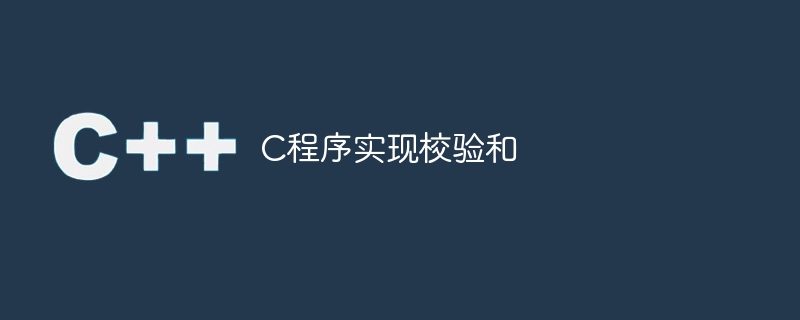

In computing, a checksum is a small-sized piece of data created from a larger data set using an algorithm with the intention that any changes made to the larger data set will result in a different checksum. Checksums are often used to verify the integrity of transmitted or stored data, as errors or modifications in the data may cause the checksum to change. They can also be used to verify the authenticity of data, since checksums are typically generated using a key known only to the sender and receiver.
There are several reasons to use checksums -
Error detection − Use checksums to detect errors that may occur during data transmission or storage. If the checksum of the received data does not match the original checksum, an error has occurred and the data needs to be retransmitted.
Data Integrity− Use checksums to ensure that data has not been modified during transmission or storage. This is important to maintain the integrity of the data and ensure it is the same as when it was originally sent.
Authentication - Checksums can be used to verify the authenticity of data because checksums are typically generated using a key known only to the sender and receiver. This helps prevent data tampering by unauthorized parties.
Space Efficient - In situations where sending the entire data over the network is inefficient (too large), the checksum can be sent as a small signature of the data, which can be sent at the destination.
Time Efficient - For big data, calculating and comparing checksums is more efficient than sending and comparing the entire data.
Easy to Implement - Checksum algorithms are generally easy to implement, which makes them a convenient choice for a variety of applications.
Cost-Effective - Checksums do not require extensive computing resources and do not add significant overhead to data transfer and storage, making it a cost-effective way to detect and detect errors in data Integrity verification.
Portable - Checksums are a widely used technology supported by many different operating systems, network protocols, and storage devices, making them portable across different platforms.
Meet different requirements − There are different types of checksum algorithms, such as CRC, MD5, SHA, etc., which are best suited for different use cases. This flexibility enables their use in a variety of applications with different requirements.
Security - By using cryptographic hash functions, checksums can be made very secure, making them difficult to forge.
There are different ways to implement checksums depending on the specific requirements of the application and the type of data that needs to be checked. The following are the general steps for implementing checksums:
Choose an appropriate checksum algorithm. There are several different checksum algorithms to choose from, such as CRC, MD5, and SHA. Each algorithm has its own pros and cons, and it's important to choose one that suits your specific use case.
Implement the selected algorithm in code. Depending on the programming language and platform you are using, there may be libraries available that provide implementations of the chosen algorithms. If not, you need to implement the algorithm yourself.
Calculate the checksum of the original data. Computes the checksum of the original data using the implemented algorithm. This checksum value should be stored or transmitted with the data.
Compare the checksum of the received data. When data is received, the same algorithm is used to calculate the checksum of the received data. Compare this value to the original checksum transmitted or stored.
If the checksums do not match, take appropriate action. If the calculated checksum of the received data does not match the original checksum, an error or modification has occurred and the data should be retransmitted or rejected.
Depending on the application and requirements, more security features can be added, such as cryptographic hash functions, salting, random numbers, etc.
It is worth noting that in some cases using checksums in conjunction with other methods such as error correction codes or error detection and correction codes (ECC/EDC) can provide more robust error tolerance, modification and data authenticity.
This is an example of a C program that calculates the checksum of a given string −
#include <stdio.h>
unsigned int checksum(char *str) {
unsigned int sum = 0;
while (*str) {
sum += *str;
str++;
}
return sum;
}
int main() {
char str[] = "Hello, World!";
printf("Checksum of '%s' is %u</p><p>", str, checksum(str));
return 0;
}
This program uses a simple algorithm to calculate the checksum of a string. It initializes the variable sum to zero and iterates over each character in the string. For each character, it adds that character's value to the sum variable. The final value of sum is returned as the checksum of the string.
Please note that the above function is just a simple example and this type of checksum is not recommended for encryption or security purposes and is prone to conflicts.
The above is the detailed content of C program to implement checksum. For more information, please follow other related articles on the PHP Chinese website!




